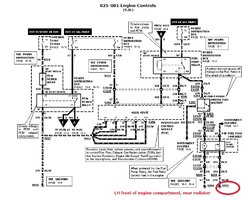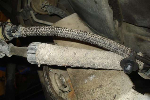1997XLTRollover
Explorer Addict
- Joined
- February 28, 2007
- Messages
- 1,321
- Reaction score
- 7
- Year, Model & Trim Level
- 1996 AWD 5.0
39.15 Key on engine off (pump running)
With engine running the pressure will change according to engine vacuum.
The formula for vacuum to psi is..
1 in. HG = .49 psi
so if you have 20 inches of vacuum you should have 9.8 lower fuel pressure
29.35psi
You were driving with the fuel pressure gauge hooked up under the wiper blade, that's what a diagnostic technician would do. Did the fuel pressure drop at wot or did it stay at aprox 39 psi?
Also O2 sensors only sense oxygen, not fuel. High voltage means rich(lack of O2), low voltage means lean(lots of O2 in exhaust). (a mixture is rich or lean on fuel) The normal operating range of a Ford narrowband O2 sensor is 0-.9 (they should vary at least from .3 to .8)
The .88 was a rich reading but you can not say the vehicle runs rich by looking at the split second in time that you captured that O2 reading. That is why we have Fuel trims. STFT and LTFT should be 0 plus or minus 5. So -5 to 5 would be fine. Between 5-10 you have a small issue. 10-15 it is a noticeable issue, 15-20 is a large issue. I have seen codes set on 1996 on up vehicles from 10 and up, but if you don't have a code it doesn't mean you don't have a problem.
If the problem might be A/F mixture related, you need to look at STFT and LTFT at Idle, and 2,000 rpm's in park.
Could you post screens shots of those please?
You want a hose for compression and leak down testing that works, try SnapOn. I have not found a vehicle that mine does not work on yet. (outside of the 3 valve heads with different size threads).
Also to check for restricted catalytic converters you would need an Exhaust back pressure tester, Snap On has those too, they are about $100.00-$150.00. I have video of mine in use at WOT on youtube(https://www.youtube.com/watch?v=O-AY7SKhYX0). I had at least 11 lbs of back pressure, Ford says no more than 8. Idle should be no more than 2-3lbs.
I was driving with the vac gauge under my wiper not fuel pressure. Next will be fuel pressure I just have to find a way to hook my fuel pressure gauge up to a longer hose so I can get it out from under the hood. My LTFT's are anywhere from 4-8 depending on load and rpm, STFT of course kind of bounce all over sometimes adding as much as 9-10 but that's rare, usually it's adding 5-7 and then pulling in the negatives when I let off the throttle. This is only when it's adding fuel, a lot of times it's around zero now that it's learned but my LTFT are still 4-8.
My fuel pressures were listed in a previous post, I'll see if I can find them.
Found it:
Engine off key on its 30psi, engine idling 30 psi, rev engine and it spikes to maybe 40 psi. Let off gas and it drops to maybe 27psi and steadys back at 30. Truck in gear brake on running wot it pins 39 psi and holds steady.
Oh and if I pull the vac line off the regulator when it's idling, it spikes to 40 and holds steady.
In an earlier post you said you disconnected the vacuum line and plugged it, that would cause a code for no purge.
I had this purge flow code before I pulled any hoses off. I pulled the battery and have driven maybe 200 miles and so far it didn't come back but I'm guessing it will at some point.











